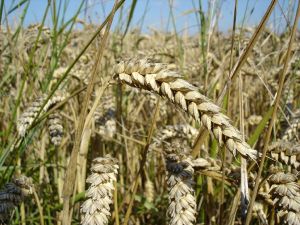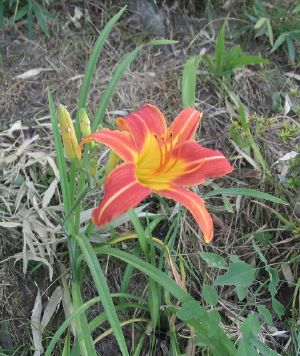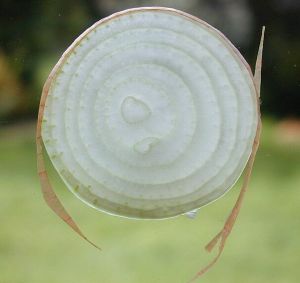Difference between revisions of "Monocotyledon" - New World Encyclopedia
Rick Swarts (talk | contribs) |
Rick Swarts (talk | contribs) |
||
| Line 1: | Line 1: | ||
{{Contracted}} | {{Contracted}} | ||
| − | [[Image:Hemerocallis_longituba.jpg|thumb|'' | + | [[Image:Hemerocallis_longituba.jpg|thumb|''Hemerocallis'' flower, with three flower parts in each whorl]] |
[[Image:Wheat_close-up.JPG|thumb|[[Wheat]], an economically important monocot]] | [[Image:Wheat_close-up.JPG|thumb|[[Wheat]], an economically important monocot]] | ||
| Line 24: | Line 24: | ||
It is generally accepted that monocotyledons evolved from within the dicotyledons, and as such the latter form a paraphyletic group (one is which the group contains its most recent common ancestor, but does not contain all the descendants of that ancestor, in this case, it does not include the monocots). The vast majority of dicots, however, form a monophyletic group (one that does include all the descendants) called the eudicots or tricolpates. These may be distinguished from all other flowering plants by the structure of their pollen. | It is generally accepted that monocotyledons evolved from within the dicotyledons, and as such the latter form a paraphyletic group (one is which the group contains its most recent common ancestor, but does not contain all the descendants of that ancestor, in this case, it does not include the monocots). The vast majority of dicots, however, form a monophyletic group (one that does include all the descendants) called the eudicots or tricolpates. These may be distinguished from all other flowering plants by the structure of their pollen. | ||
| − | The traditionally listed differences between monocotyledons and dicotyledons are as follows. This is a broad sketch only, not invariably applicable, as there are a number of exceptions. The differences indicated are more true for | + | The traditionally listed differences between monocotyledons and dicotyledons are as follows. This is a broad sketch only, not invariably applicable, as there are a number of exceptions. The differences indicated are more true for monocots versus eudicots, as per the Angiosperm Phylogeny Group II (APG II) system: |
'''Flowers:''' In monocots, flowers are trimerous (number of flower parts in a whorl in threes) while in dicots the flowers are tetramerous or pentamerous (flower parts are in fours or fives). | '''Flowers:''' In monocots, flowers are trimerous (number of flower parts in a whorl in threes) while in dicots the flowers are tetramerous or pentamerous (flower parts are in fours or fives). | ||
| Line 41: | Line 41: | ||
However, these differences are not hard and fast: some monocots have characteristics more typical of dicots, and vice-versa. This is in part because "dicots" are a paraphyletic group with respect to monocots, and some dicots may be more closely related to monocots than to other dicots. In particular, several early-branching lineages of "dicots" share "monocot" characteristics, suggesting that these are not defining characters of monocots. When monocots are compared to eudicots, the differences are more concrete. | However, these differences are not hard and fast: some monocots have characteristics more typical of dicots, and vice-versa. This is in part because "dicots" are a paraphyletic group with respect to monocots, and some dicots may be more closely related to monocots than to other dicots. In particular, several early-branching lineages of "dicots" share "monocot" characteristics, suggesting that these are not defining characters of monocots. When monocots are compared to eudicots, the differences are more concrete. | ||
| − | == | + | ==History and taxonomy== |
| − | The monocots are considered to form a | + | The monocots are considered to form a monophyletic group arising early in the history of the [[flowering plant]]s. The earliest [[fossil]]s presumed to be monocot remains date from the [[Cretaceous|early Cretaceous]] period. |
| − | |||
| − | |||
| − | |||
| − | |||
| − | |||
| + | Taxonomists have considerable latitude in naming this group, as the monocots are a group above the rank of family. Article 16 of the ''International Code of Botanical Nomenclature (ICBN)'' allows either a descriptive name or a name formed from the name of an included family. | ||
[[Image:Monocot_vs_dicot_crop_Pengo.jpg|thumb|Grass sprouting on left (a monocot), showing a single cotyledon. Compared to a dicot (right)]] | [[Image:Monocot_vs_dicot_crop_Pengo.jpg|thumb|Grass sprouting on left (a monocot), showing a single cotyledon. Compared to a dicot (right)]] | ||
Historically, the monocotyledons were named: | Historically, the monocotyledons were named: | ||
| − | * | + | * Monocotyledoneae in the de Candolle system and the Engler system. |
| − | * [[Monocotyledones]] in the [[Bentham & Hooker system]] and the [[Wettstein system]] | + | * [[Monocotyledones]]* in the [[Bentham & Hooker system]]* and the [[Wettstein system]]* |
| − | * | + | * Class [[Liliopsida]]* in the [[Takhtajan system]]* and the [[Cronquist system]]*. |
| − | * | + | * Subclass [[Liliidae]]* in the [[Dahlgren system]]* and the [[Thorne system (1992)]]*. |
| − | * [[ | + | * [[Clade]] monocots in the [[APG system]]* and the [[APG II system]]*. |
Each of the systems mentioned above use their own internal taxonomy for the group. The monocotyledons are famous as a group that is extremely stable in its outer borders (it is a well-defined, coherent group), while in its internal taxonomy is extremely unstable (historically no two authoritative systems have agreed with each other on how the monocotyledons are related to each other). | Each of the systems mentioned above use their own internal taxonomy for the group. The monocotyledons are famous as a group that is extremely stable in its outer borders (it is a well-defined, coherent group), while in its internal taxonomy is extremely unstable (historically no two authoritative systems have agreed with each other on how the monocotyledons are related to each other). | ||
| + | |||
| + | According to the World Conservation Union (International Union for the Conservation of Nature and Natural Resources or IUCN), there are 59,300 species of monocots.[http://www.redlist.org/info/tables/table1] | ||
==References and external links== | ==References and external links== | ||
| − | * Chase | + | * Chase, M. W., D. E. Soltis, P. S. Soltis, P. J. Rudall, M. F. Fay, W. J. Hahn, S. Sullivan, J. Joseph, M. Molvray, P. J. Kores, T. J. Givnish, K. J. Sytsma, and J. C. Pires. 2000. Higher-level systematics of the monocotyledons: An assessment of current knowledge and a new classification. In: K. L. Wilson and D. A. Morrison, eds., ''Monocots: Systematics and Evolution.''. Melbourne: CSIRO. 3-16. ISBN 0-643-06437-0 |
| − | *[http://tolweb.org/tree?group=Monocotyledons&contgroup=Euangiosperms Tree of Life Web Project: | + | * Hahn, W. J. 1997. [http://tolweb.org/tree?group=Monocotyledons&contgroup=Euangiosperms Monocotyledons]. In ''Tree of Life Web Project'', Version 01 January 1997 (under construction), http://tolweb.org/ |
| − | * | + | * IUCN. 2006. [http://www.redlist.org/info/tables/table1 Numbers of threatened species by major groups of organisms (1996–2004)]. ''International Union for Conservation of Nature and Natural Resources''. Retrieved December 15, 2006. |
| + | |||
[[Category:Life sciences]] | [[Category:Life sciences]] | ||
{{credit|94602548}} | {{credit|94602548}} | ||
Revision as of 19:48, 31 January 2007

Monocotyledons or monocots are a major group of flowering plants (angiosperms) whose members typically have one cotyledon, or embryonic leaf, in their seeds, and whose flowers typically have parts in threes or multiplies of threes. Flowering plants that are not monocotyledons are typically designated as dicotyledons, a traditional (but paraphyletic) flowering plant group whose seed typically contains two cotyledons, and whose flower parts are generally in fours or fives.
As a member of the angiosperms or flowering plants, monocots (and dicots) bear their reproductive organs in a structure called a flower and cover their seeds by including them in a true fruit. (The ovule is enclosed within a carpel, the female reproductive organ of a flower, which will lead to a fruit.) Angiosperms are a major group of land plants, with 250,000 species, and are one of two groups in the seed plants. (The other seed plant group is gymnosperms, in which the ovule is not enclosed at pollination and the seeds are not in a true fruit.)
Monocots dominate great parts of the earth and comprise the majority of agricultural plants in terms of biomass produced. There are between 50,000 and 60,000 species within this group.
The largest family in this group (and in the flowering plants) are the orchids (usually taken to be the family Orchidaceae, but sometimes treated at the rank of order), with about twenty thousand species. These have very complex (and striking) flowers, adapted for highly specific insect pollination.
The economically most important family in this group (and in the flowering plants) are the grasses, family Poaceae (Gramineae). These include all the true grains (rice, wheat, maize, etc.), the pasture grasses, and the bamboos. This family of the true grasses have evolved in another direction, becoming highly specialized for wind pollination. Grasses produce much smaller flowers, which are gathered in highly visible plumes (inflorescences).
A further noteworthy, and economically important, family is the palm family Arecaceae (Palmae).
Characteristics
The name monocotyledons is derived from the traditional botanical name Monocotyledones, which derives from the fact that most members of this group have one cotyledon, or embryonic leaf, in their seeds. From a diagnostic point of view, the number of cotyledons is neither a particularly handy (as they are only present for a very short period in a plant's life), nor totally reliable character.
Nevertheless, monocots are a distinctive group. One of the most noticeable traits is that a monocot's flower is trimerous, with the flower parts in threes or in multiples of three. For example, a monocotyledon's flower typically has three, six, or nine petals. Many monocots also have leaves with parallel veins.

It is generally accepted that monocotyledons evolved from within the dicotyledons, and as such the latter form a paraphyletic group (one is which the group contains its most recent common ancestor, but does not contain all the descendants of that ancestor, in this case, it does not include the monocots). The vast majority of dicots, however, form a monophyletic group (one that does include all the descendants) called the eudicots or tricolpates. These may be distinguished from all other flowering plants by the structure of their pollen.
The traditionally listed differences between monocotyledons and dicotyledons are as follows. This is a broad sketch only, not invariably applicable, as there are a number of exceptions. The differences indicated are more true for monocots versus eudicots, as per the Angiosperm Phylogeny Group II (APG II) system:
Flowers: In monocots, flowers are trimerous (number of flower parts in a whorl in threes) while in dicots the flowers are tetramerous or pentamerous (flower parts are in fours or fives).
Pollen: In monocots, pollen has one furrow or pore while dicots have three.
Seeds: In monocots, the embryo has one cotyledon, while the embryo of the dicot has two.
Stems: In monocots, vascular bundles in the stem are scattered, in dicots they are arranged in a ring.
Roots: In monocots, roots are adventitious (developing on a part other than the radical, such as on stems and leaves), while in dicots they develop from the radicle (primary root and its lateral roots).
Leaves: In monocots, the major leaf veins are parallel, while in dicots they are reticulate.
However, these differences are not hard and fast: some monocots have characteristics more typical of dicots, and vice-versa. This is in part because "dicots" are a paraphyletic group with respect to monocots, and some dicots may be more closely related to monocots than to other dicots. In particular, several early-branching lineages of "dicots" share "monocot" characteristics, suggesting that these are not defining characters of monocots. When monocots are compared to eudicots, the differences are more concrete.
History and taxonomy
The monocots are considered to form a monophyletic group arising early in the history of the flowering plants. The earliest fossils presumed to be monocot remains date from the early Cretaceous period.
Taxonomists have considerable latitude in naming this group, as the monocots are a group above the rank of family. Article 16 of the International Code of Botanical Nomenclature (ICBN) allows either a descriptive name or a name formed from the name of an included family.
Historically, the monocotyledons were named:
- Monocotyledoneae in the de Candolle system and the Engler system.
- Monocotyledones in the Bentham & Hooker system and the Wettstein system
- Class Liliopsida in the Takhtajan system and the Cronquist system.
- Subclass Liliidae in the Dahlgren system and the Thorne system (1992).
- Clade monocots in the APG system and the APG II system.
Each of the systems mentioned above use their own internal taxonomy for the group. The monocotyledons are famous as a group that is extremely stable in its outer borders (it is a well-defined, coherent group), while in its internal taxonomy is extremely unstable (historically no two authoritative systems have agreed with each other on how the monocotyledons are related to each other).
According to the World Conservation Union (International Union for the Conservation of Nature and Natural Resources or IUCN), there are 59,300 species of monocots.[1]
References and external links
- Chase, M. W., D. E. Soltis, P. S. Soltis, P. J. Rudall, M. F. Fay, W. J. Hahn, S. Sullivan, J. Joseph, M. Molvray, P. J. Kores, T. J. Givnish, K. J. Sytsma, and J. C. Pires. 2000. Higher-level systematics of the monocotyledons: An assessment of current knowledge and a new classification. In: K. L. Wilson and D. A. Morrison, eds., Monocots: Systematics and Evolution.. Melbourne: CSIRO. 3-16. ISBN 0-643-06437-0
- Hahn, W. J. 1997. Monocotyledons. In Tree of Life Web Project, Version 01 January 1997 (under construction), http://tolweb.org/
- IUCN. 2006. Numbers of threatened species by major groups of organisms (1996–2004). International Union for Conservation of Nature and Natural Resources. Retrieved December 15, 2006.
Credits
New World Encyclopedia writers and editors rewrote and completed the Wikipedia article in accordance with New World Encyclopedia standards. This article abides by terms of the Creative Commons CC-by-sa 3.0 License (CC-by-sa), which may be used and disseminated with proper attribution. Credit is due under the terms of this license that can reference both the New World Encyclopedia contributors and the selfless volunteer contributors of the Wikimedia Foundation. To cite this article click here for a list of acceptable citing formats.The history of earlier contributions by wikipedians is accessible to researchers here:
The history of this article since it was imported to New World Encyclopedia:
Note: Some restrictions may apply to use of individual images which are separately licensed.


